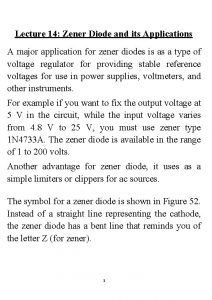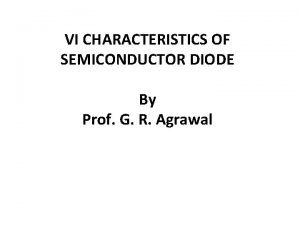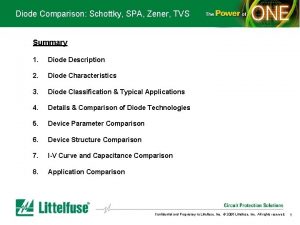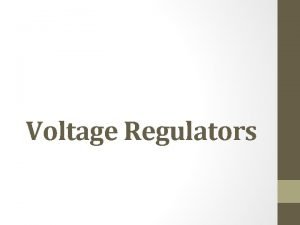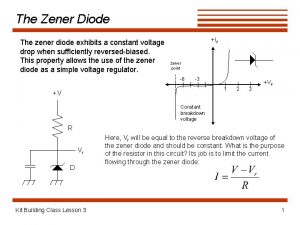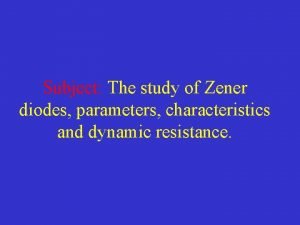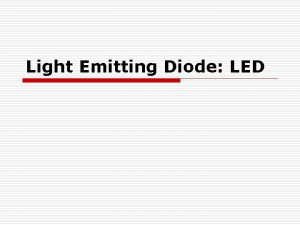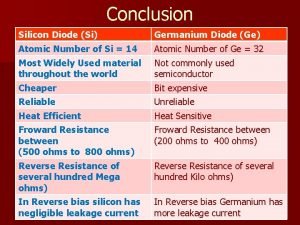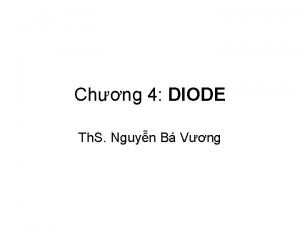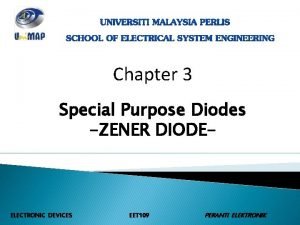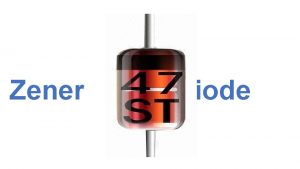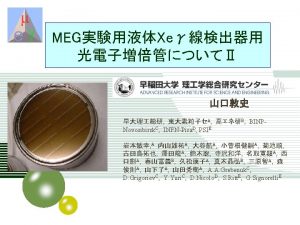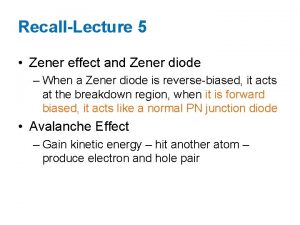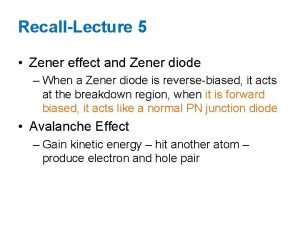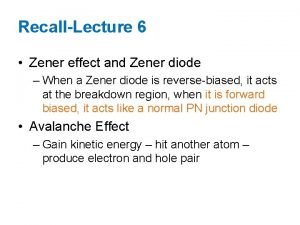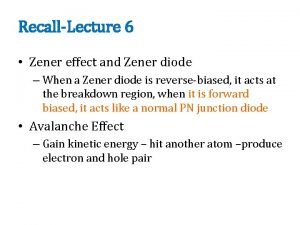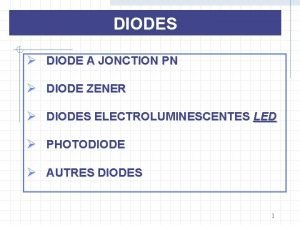Lecture 14 Zener Diode and its Applications A











- Slides: 11

Lecture 14: Zener Diode and its Applications A major application for zener diodes is as a type of voltage regulator for providing stable reference voltages for use in power supplies, voltmeters, and other instruments. For example if you want to fix the output voltage at 5 V in the circuit, while the input voltage varies from 4. 8 V to 25 V, you must use zener type 1 N 4733 A. The zener diode is available in the range of 1 to 200 volts. Another advantage for zener diode, it uses as a simple limiters or clippers for ac sources. The symbol for a zener diode is shown in Figure 52. Instead of a straight line representing the cathode, the zener diode has a bent line that reminds you of the letter Z (for zener). 1

Figure 52: Zener diode symbol. A zener diode is a silicon pn junction device that is designed for operation in the reverse-breakdown region. The breakdown voltage of a zener diode is set by carefully controlling the doping level during manufacture. Recall, from the discussion of the diode characteristic curve, that when a diode reaches reverse breakdown, its voltage remains almost constant even though the current changes drastically, and this is the key to zener diode operation. This volt-ampere characteristic is shown again in Figure 53 with the normal operating region for zener diodes shown as a shaded area. 2

Figure 53: General zener diode V-I characteristic. Breakdown Characteristics Figure 54 shows the reverse portion of a zener diode’s characteristic curve. Notice that as the reverse voltage (VR) is increased, the reverse current (IR) remains extremely small up to the “knee” of the curve. The reverse current is also called the zener current, IZ. At this point, the breakdown effect begins; the internal zener resistance, also called zener impedance (ZZ), begins to decrease as the 3

reverse current increases rapidly. From the bottom of the knee, the zener breakdown voltage (VZ) remains essentially constant although it increases slightly as the zener current, Iz, increases. Figure 54: Reverse characteristic of a zener diode. VZ is usually specified at a value of the zener current known as the test current. Zener Regulation The ability to keep the reverse voltage across its terminals essentially constant is the key feature of the zener diode. 4

A zener diode operating in breakdown acts as a voltage regulator because it maintains a nearly constant voltage across its terminals over a specified range of reverse-current values. A minimum value of reverse current, IZK, must be maintained in order to keep the diode in breakdown for voltage regulation. You can see on the curve in Figure 54 above, that when the reverse current is reduced below the knee of the curve, the voltage decreases drastically and regulation is lost. Also, there is a maximum current, IZM, above which the diode may be damaged due to excessive power dissipation. So, basically, the zener diode maintains a nearly constant voltage across its terminals for values of reverse current ranging from IZK to IZM. A nominal zener voltage, VZ, is usually specified on a datasheet at a value of reverse current called the zener test curret, IZ. Zener Equivalent Circuits Figure 55 shows the ideal model (first approximation) of a zener diode in reverse breakdown and its ideal characteristic curve. It has a 5

constant voltage drop equal to the nominal zener voltage. Figure 55: Ideal zener diode equivalent circuit model and the characteristic curve. 6

circuit and the characteristic curve illustrating ZZ. Zener Regulation with a Variable Input Voltage To illustrate regulation, let’s use the ideal model of the 1 N 4740 A zener diode (ignoring the zener resistance) in the circuit of Figure below. The absolute lowest current that will maintain regulation is specified at IZK, which for the 1 N 4740 A is 0. 25 m. A and represents the no-load current. The maximum current is not given on the datasheet but 7

can be calculated from the power specification of 1 W, which is given on the datasheet. Zener diodes are specified to operate at a maximum power called the maximum power dissipation, PD(max). 8

Example: Determine the minimum and the maximum input voltages that can be regulated by the zener diode in Figure below, where VZ = 5. 1 V at IZ = 49 m. A, IZK = 1 m. A ZZ = 7 Ω, for simplicity, assume this value of Zz over the range of current values. 9

Solution: The equivalent circuit is shown in Figure below. H 10

Review Questions: 1. What is the zener diode and what are its advantages? 2. In what region of their characteristic curve are zener diodes operated? 3. At what value of zener current is the zener voltage normally specified? 4. How does the zener impedance affect the voltage across the terminals of the device? 11
 Zener diode application
Zener diode application Pn junction diode and zener diode difference
Pn junction diode and zener diode difference Schottky diode vs zener diode
Schottky diode vs zener diode Transistor shunt voltage regulator
Transistor shunt voltage regulator Zener diode
Zener diode Zener diode parameters
Zener diode parameters Zener diode for led lights
Zener diode for led lights V-i characteristics of silicon and germanium diodes
V-i characteristics of silicon and germanium diodes Chất bán dẫn
Chất bán dẫn Zener diode function
Zener diode function Zener diode example
Zener diode example Special purpose diode
Special purpose diode
